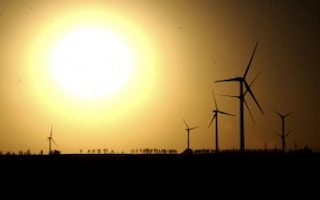Utility companies are facing challenges unimagined five years ago on preparing grids for renewable energy, said experts at a clean energy conference on Tuesday.
Speakers at the Clean Energy Expo Asia said companies globally were facing a steep learning curve in their attempts to adapt existing power grids for future electricity scenarios, in which electricity production is much more volatile with renewable energy in the mix.
Dr Bartosz Wojszczyk, global director of GE’s smart grid technologies section, said that existing electricity grids were already operating at close to their limits. “Adding renewables doesn’t help,” he noted.
Today’s grids are operating differently from their original design, and grid operators incorporating wind energy, for example, have had to address a number of challenges, explained Dr Wojszczyk.
Those challenges include weak powerline infrastructure at remote locations where wind power is generated and adapting to rapid and sometimes unexpected changes to wind turbine performance.
Another major issue with integrating wind power into electricity grids is the limited operating capacity of wind turbines, which on average generate only 40 per cent of their maximum capacity. Transmission lines need to be built for full capacity, and grid operators need to justify their investment in the infrastructure, said Dr Wojszczyk.
The way to fix the capacity problem, he said, is by combining energy sources such as wind and solar in hybrid power plants.
Improved wind turbine technologies are, in fact, making wind turbines act more like power plants, he added, which can be regulated by an operator.
Over the past decade, the industry has studied existing projects to learn how to deal with grid constraints, how to more accurately forecast wind conditions and how to make up for low energy output from wind turbines.
Experts are now talking about using renewable energy for regulating power in grids, a function that is possible because of the technology that allows operators to control wind turbines even when there is little or no wind, said Dr Wojszczyk. Five years ago, wind turbine operators would have had to disengage turbines in those conditions, he noted.
In 20 years, said Dr Wojszczyk, he expects to see additional innovations and capabilities within the wind sector, and a completely different business model for utilities.
Professor Christophe Menke from the University of Applied Sciences in Trier, Germany, cautioned that the innovations are needed not only in technology, but in energy markets and policies as well.
“We have to prepare existing grids to cope,” he said, because renewable energy changes the traditional operation of conventional power plants, which now have to be able to adjust quickly to fluctuating demands.
Professor Menke illustrated the problem with experiences from Germany, which is integrating significant amounts of solar and wind energy into its grids.
Several years ago, Germany experienced a brief period of negative energy prices due to the interaction of renewable energy supplies and electricity market conditions. The electricity prices, which are determined by market mechanisms, fell below zero. As a result, nuclear plants had to either pay to supply electricity to the grid or temporarily stop providing energy.
“We don’t want to make the utilities bankrupt,” said Professor Menke, adding that energy markets were still learning how to manage those situations.
He provided several suggestions for renewable energy integration into energy markets, including better management of energy fed into the grid through energy storage, improved forecasting of energy generation and better management of demand for electricity.
He also suggested a “system service bonus”, which would give power plants incentives to withhold energy from the grid in times of excessive supply.
But the biggest lesson learnt, said Professor Menke, is that there is no one solution, and that success will require flexibility and better communication.
To this end, he cited a study from the International Energy Agency, which found that non-technical issues can have a big impact on the ability of a country to exploit renewable energy resources from multiple sources.
He noted that Japan scored unexpectedly low, considering its quality of infrastructure and technology, mainly because it is ill adapted to handle the new variety of renewable energy options available. “Five years ago, that grid was perfect,” he said, referring to Japan’s electricity grid.
Professor Menke noted that long-term planning and investment were needed to adapt grid structures. “We are getting completely new players; we are getting reverse flow. We are getting challenges we (never saw) five years ago,” he said.
Eco-Business.com’s coverage of Clean Energy Expo Asia 2011, part of Singapore International Energy Week 2011, is brought to you by Schneider Electric.
Click here to read all stories from Clean Energy Expo Asia 2011.

















